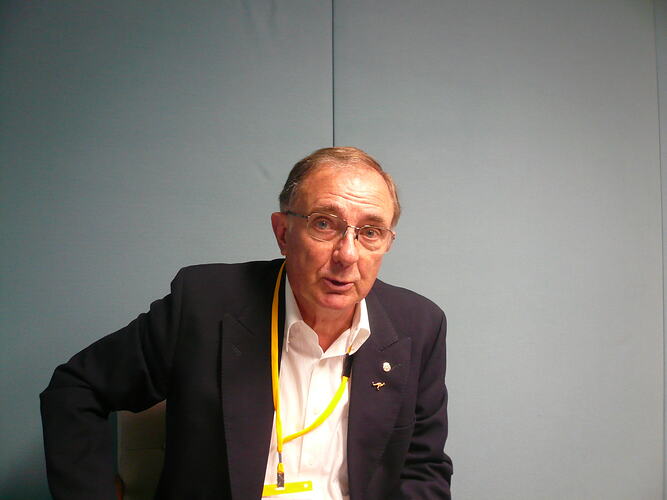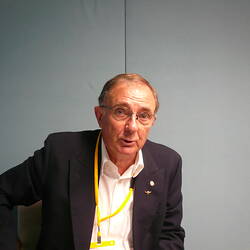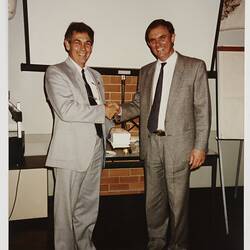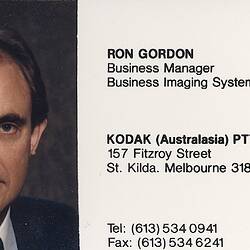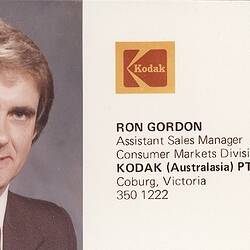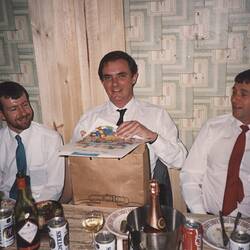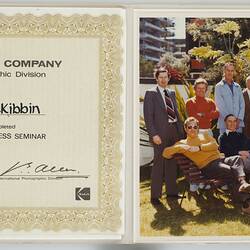Summary
A career in customer service engineering and sales, 1965-1990.
Ron Gordon, Kodak Australasia Pty Ltd: Customer Service and Sales, 1965 - 1990
Customer Equipment Service Division
Ron joined Kodak Australasia in 1965 as a customer service engineer in the Customer Equipment Service Division at Kodak's Coburg plant. He had a technical background, having completed the technicians' training program with the PMG (Post Master General's Department, forerunner of Telstra and Australia Post) and worked for the Overseas Telecommunications Commission for a few years.
Although Kodak was renowned for its consumer photographic products such as cameras and film, the company also supplied a large range of imaging equipment and systems to business, government and the health industry. Film processing machines, x-ray machines, and motion picture and audio/visual equipment were imported into Australia from Kodak factories overseas. Ron's first job at Kodak was to install and service such equipment and provide after sales service. His preference was to work with the developing electronics based technology, as he explains, "I was focused on communications, electronics. I pursued that with getting more training at RMIT, the Royal Melbourne Institute of Technology, in industrial electronics, and also in computer electronics. At that stage computers were still the domain of probably one company, IBM. So consequently my job was to understand where some of those machines would fit in with Kodak too, because Kodak also had some of its process control using some of these machines, they were scientific based computers."
Business imaging systems
After four or five years in customer service, Ron decided he would like to try sales and marketing. His technical background equipped him for a move into the Business Imaging Systems Division, which sold systems for microfilming and storing documents, photographs and other records generated by government, banks, and other large businesses. One such system was the computer output microfilmer, known as COM, which built on Kodak's long experience in micrographics. Ron also worked with trucking companies to introduce a revolutionary computerised microfilm system using barcodes to keep track of goods in transit.
In 1979 Ron moved to Sydney, where his experience was needed for a rapidly growing market in business imaging systems. Ron recalls, "Sydney is very much a revolutionary market where Melbourne's very conservative. Melbourne was always a follower ..."
After two years Ron returned to Melbourne, and was given the position of Assistant Sales Manager in Consumer Markets, which was a much larger division than his previous group Commercial Markets. Consumer Markets was the division responsible for distributing Kodak's range of film products used by amateur photographers. This was Kodak's biggest selling range and much of it was manufactured in Kodak Australasia's Coburg factory. Ron found that Consumer Markets, unlike Commercial Markets, had no system of monitoring the activities of its 20 sales people, so it was his job to create an appropriate system. According to Ron, "The job of the sales people, apart from the obvious of selling the product, is to understand what the current need is, and does our product meet the current need, and if it doesn't, what are we going to do?"
Another part of his job was to sort out customer complaints and take any necessary action. He remembers one particular technical problem he addressed. "Kodak was producing photographic prints and the colour was out of balance. So I went over to Pacific, who were our competitors at the time and I said to the bloke running the lab there, 'How do you maintain quality control?' And he told me. So I went back to the boys who ran the labs here in Australia and I said, 'You need to know, this is how Pacific, our biggest competitor, handles this. I expect you guys to be able to do it too.' They didn't take kindly to me telling them that, and I think their gift was a lab coat. They called me 'Mr Colour' for a while."
In 1984 Ron moved back to Business Imaging Systems as Business Manager, remaining in that position until 1990. Ron had seen his future 'as being in Kodak', but he resigned over a difference of opinion with senior management.
Kodak Express and beyond
In the 1980s, when Ron was Consumer manager, Kodak had introduced Kodak Express as a way of competing with the new mini-labs that had challenged Kodak's market share in photo processing. Kodak Express stores were run by small businesses under licence to Kodak. They were required to stock Kodak products and provide a one-hour photo processing service. Ron took the opportunity to go into business by taking over a Kodak Express store in Bulleen. He saw an added benefit in employing his teenage children, to 'teach them how to work'. Two of his daughters worked full time in the business before moving into other careers involving photography. Ron and his family ran the Kodak Express business until 1997. He subsequently worked as marketing manager for a national company that distributed discounted goods, including Kodak products, to social clubs until he retired in 2007.
References
Beale, Nigel, 'The History of Kodak in Australia', 1983 (unpublished manuscript).
HT 35632 - Interview with Ron Gordon, interviewed by Lesley Alves 21 November 2013.
More Information
-
Keywords
Photographic Products, Retailing, Biographies, Managers, Sales Representatives, Marketing, Packaging
-
Authors
-
Article types
